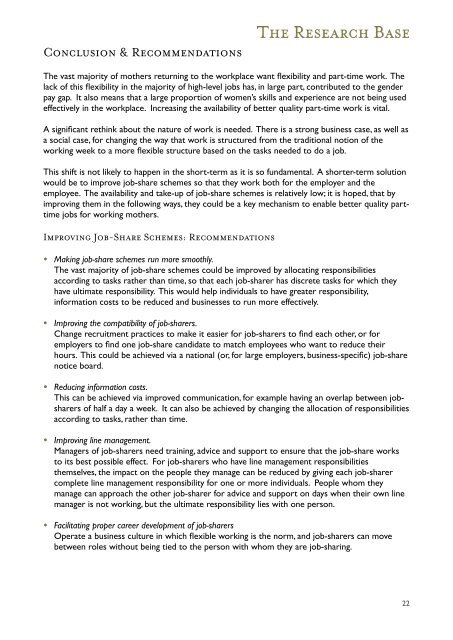Tasks, Not Time_1
Tasks, Not Time_1
Tasks, Not Time_1
Create successful ePaper yourself
Turn your PDF publications into a flip-book with our unique Google optimized e-Paper software.
Conclusion & RecommendationsThe vast majority of mothers returning to the workplace want flexibility and part-time work. Thelack of this flexibility in the majority of high-level jobs has, in large part, contributed to the genderpay gap. It also means that a large proportion of women’s skills and experience are not being usedeffectively in the workplace. Increasing the availability of better quality part-time work is vital.A significant rethink about the nature of work is needed. There is a strong business case, as well asa social case, for changing the way that work is structured from the traditional notion of theworking week to a more flexible structure based on the tasks needed to do a job.This shift is not likely to happen in the short-term as it is so fundamental. A shorter-term solutionwould be to improve job-share schemes so that they work both for the employer and theemployee. The availability and take-up of job-share schemes is relatively low; it is hoped, that byimproving them in the following ways, they could be a key mechanism to enable better quality parttimejobs for working mothers.Improving Job-Share Schemes: Recommendations• Making job-share schemes run more smoothly.The vast majority of job-share schemes could be improved by allocating responsibilitiesaccording to tasks rather than time, so that each job-sharer has discrete tasks for which theyhave ultimate responsibility. This would help individuals to have greater responsibility,information costs to be reduced and businesses to run more effectively.• Improving the compatibility of job-sharers.Change recruitment practices to make it easier for job-sharers to find each other, or foremployers to find one job-share candidate to match employees who want to reduce theirhours. This could be achieved via a national (or, for large employers, business-specific) job-sharenotice board.• Reducing information costs.This can be achieved via improved communication, for example having an overlap between jobsharersof half a day a week. It can also be achieved by changing the allocation of responsibilitiesaccording to tasks, rather than time.• Improving line management.Managers of job-sharers need training, advice and support to ensure that the job-share worksto its best possible effect. For job-sharers who have line management responsibilitiesthemselves, the impact on the people they manage can be reduced by giving each job-sharercomplete line management responsibility for one or more individuals. People whom theymanage can approach the other job-sharer for advice and support on days when their own linemanager is not working, but the ultimate responsibility lies with one person.• Facilitating proper career development of job-sharersOperate a business culture in which flexible working is the norm, and job-sharers can movebetween roles without being tied to the person with whom they are job-sharing.22


